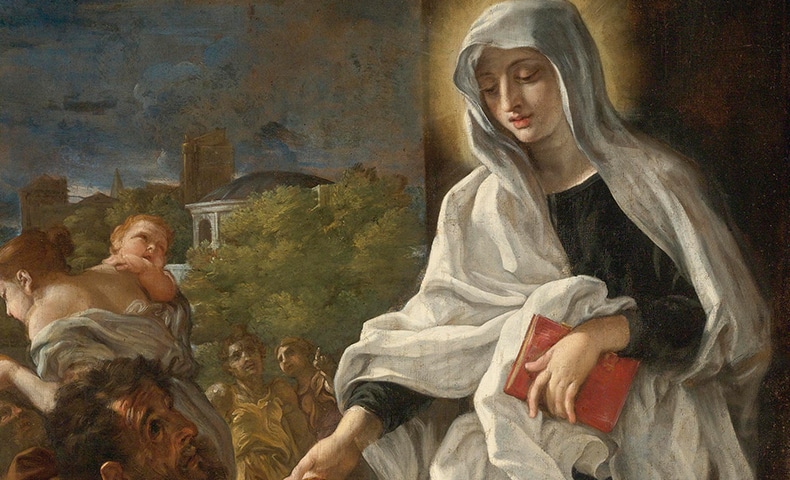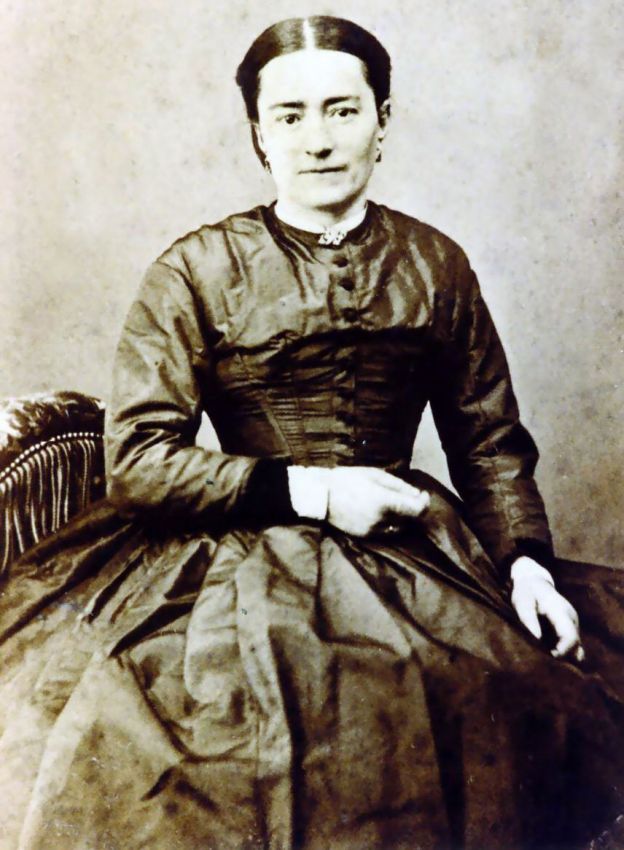Is hell this bad?
Sounds like an ignorant question.
But mulling the depictions of that netherworld in a book about the visions of Saint Frances of Rome, one is nonetheless taken aback.
What should be known is that Saint Frances was a noblewoman in Rome who, even as a young girl, disdained the trivialities and flippancies of childish games, along with all the vanities and temptations of this world. This we learn in The Visions of Saint Frances of Rome.
At age eleven, she consecrated her virginity to God. Already she had resolved to enter a convent.
That didn’t happen: Frances’s well-to-do parents would have none of it, it turns out, and the girl, above all, was obedient. So it was that eventually she married a distinguished man of affluence, although one might say she entered an interior “convent,” leading a life of strict prayer, much penance, avoidance of parties and theatres, and — contrary to others of her societal “standing” — wore very simple attire.
In other words, Frances of Rome disdained distractions despite her money and marital standing.
Deciding to help other married noblewomen who likewise wished to avoid worldliness, the saint established a house of Benedictine oblates where those enrolled could live a life of prayer but without the binding of formal vows. She did this with the generous permission of her husband, whose name was Lorenzo.
Unfortunately, Lorenzo was sent into exile (we’re not sure why), and Frances kept to her unworldly course with increased ardency, practicing even greater austerity and assisting the poor and degraded women of the city instead of hobnobbing with the noblesse.
Here we get to the meat: For during long vigils of prayer, during which she subsisted on a single meal each day (herbs, legumes, pure water), “Frances was graced with innumerable visions and spiritual graces,” says the book. “Often when witnessing the elevation of the Most Blessed Sacrament, she would be taken up into ecstasy of ecclesial contemplation and would remain physically immobile for some time.
“She was often severely vexed by many demons, but was granted a very powerful guardian angel, whose presence she is reported to have been able to see clearly.”
One has to discern even what is “seen” by such holy people (they are just that: people, human). But her visions would draw the support, among many others, of Saint Zélie Martin, mother of Thérèse of Lisieux (and one who saw all five of her daughters enter religious life).
In her visions, Frances took tours of hell and its various levels, later writing about the “geography” of it: the entrance of which had an enormous inscription, in “grim and dreadful” dark crimson that supposedly said, “Behold, this place is hell, where souls condemned must dwell. Of all the lands accursed this is by far the worst! From pain there is no rest within these realms unblessed: the flames here burn forever, the torment ceased never!”
An actual inscription, or, in such visions, Heaven’s way of symbology?
That’s for us all to contemplate as we learn, right from the initial chapters, that while fearful and imposing enough, frightening enough, at its entrance, hell gets much worse — much.
Dense clouds. Opaque shadows. An almost palpable darkness, “which no human words could ever suffice to express, nor human senses could comprehend.”
This is precisely what we heard from a woman in Washington who had a near-death experience.
There are — claimed Frances — three realms of Hades, the bottom a netherworld where punishments reach “infinite and unbounded extremity.”
“Of all the creatures and entities which inhabited this infernal kingdom, there was one who stood out as the largest and most dominant of them all—an enormous and ancient dragon,” the mystic said. “Indeed, this beast was present in all three levels of hell, with his head in the uppermost level, his body in the middle level, and his tail reaching into the nethermost region.
“His gigantic and monstrous head, posited in the top level, was turned towards the entrance. And his hideous mouth gaped open, with his tongue hanging out in a sinister fashion. Out of this opened orifice poured a fire that burned with scorching intensity, yet emitted no light. A putrescent and nauseating stench also issued from his mouth. Similarly, black fire — hot, fetid — also seeped through his eyes and ears.”
It was there that the saint heard the horrible cries and wails of those condemned, along with appalling blasphemies.
A number of hell accounts, including one by Bryan Melvin, an atheistic construction worker in Arizona who “died” after contracting cholera from contaminated water at a work site, likewise saw terrifying creatures [see below]. Ditto for a fellow from California we’ve reported on before, Shawn Weed.
But back to Saint Frances: she also allegedly encountered Satan or Lucifer himself.
“His countenance was utterly terrifying and he sat positioned upon a wooden beam in the middle region of the region of the inferno,” the book says. “His head reached into the uppermost region, while his feet reached to the bottom level. Thus he lay, effectively occupying all three parts of hell simultaneously. His arms and legs were extended outwards, yet in such a way that they bore no likeness to a cross (for that holy form is strictly not permitted in hell).”
“He was crowned with a kind of sinister tiara, resembling the antlers of some great deer or elk. And out of the main horns of these antlers, innumerable smaller horns sprang forth, with sparks and flames issuing from each. Metallic chains, glowing red hot, were bound around his hands, feet, and torso. One of these chains was extended from Satan to the great dragon that Frances had seen before.”
Not pleasant stuff. And with it: the cries of sheer pain.
In the saint’s view, some souls were swallowed by the dragon, regurgitated, and covered with disgusting substance.
At the gates of hell was an angel guarding the nearby realm of “limbo.”
That too the saint said she saw, describing the darkest part as reserved for infants conceived by monks, nuns, or priests, or from incestuous relationships. They were in peace but also darkness.
Does a Merciful God really send the unbaptized or scandal-conceived there?
(It’s important to note that limbo has never been defined as a doctrine of the faith by the Magisterium of the Catholic Church. Instead, the Church entrusts these souls to the mercy of God.)
As for hell, Saint Frances warned that it can be a destination not just for atheists. Beware “traitors, murderers, apostates, and schismatics” also (claimed Frances).
And “perverts, usurers, and blasphemers.”
Their torments — with hideous weapons and tools — are not for the faint of heart. There were also, it’s claimed, visits by the saint to regular purgatory.
Whatever our discernment, it’s a compelling read, and the lesson: life is a test, a glorious test but a dangerous one when lived without love and closeness to God.
[resources: After Life, The Other Side, and What You Take To Heaven]
First: did this man glimpse hell?
And this one Heaven?
+




